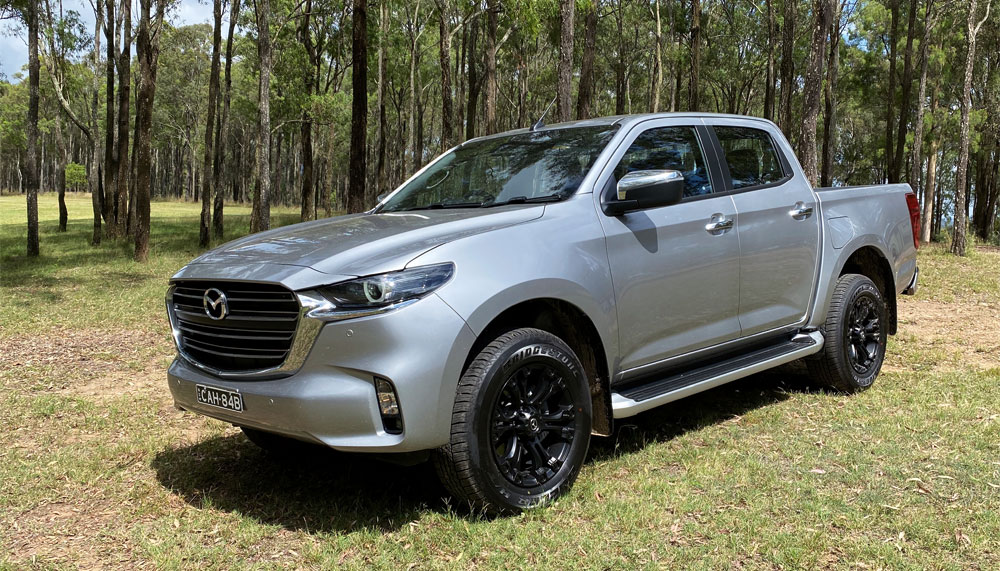Mazda’s new BT50 dual cab ute is well built and provisioned, but unsettling to drive.
Story + Photo Mark Muller
The 2021 Mazda BT-50 sees the well-regarded Japanese brand shift from a decade-long partnership with Ford that underpinned the previous generation BT-50 to a new relationship with Isuzu and a shared platform with the D-Max, with both vehicles being made by Isuzu Ute in Thailand. Essentially the differences are in the styling and Mazda’s design language carries over well to the smooth lines of the BT-50. Looks are a personal thing, but to our eyes, the BT-50 looks good.
The cabin of the high-spec GT model that OUTBACK tested is quiet and comfortable. Leather seating, refined driver ergonomics, and fit and finish are all good. It’s clearly aimed at a market looking for that combination of car-like surrounds and ute-like practicality.
The BT-50 comes in seven dual-cab variants, with three 4x2 offerings and four 4x4. Prices range from $36,550 for the entry-level XT dual cab chassis to the $59,990 for the top-end GT dual cab pick-up, before on-road costs. The whole range has a full suite of safety features that have earned it a five-star ANCAP safety rating. These include autonomous emergency braking, blind-spot monitoring, electronic stability control and emergency lane-keeping and lane-departure warnings. The higher models also have speed sign recognition cameras, and the ability to use that info to ensure you don’t break the speed limit.
All BT-50s are powered by a 3L turbo diesel four-cylinder engine producing 140kW at 3600rpm, and 450Nm of torque developing from 1600rpm to 2600rpm. This engine is mated to either a six-speed manual or six-speed automatic.
Across almost 500km of mixed city and country driving, the Mazda returned an average fuel usage of 8L/100km – pretty good given the 2.1-tonne kerb weight and 3.2-tonne GVM, which translates to a payload rating of 1095kg and a braked tow rating of up to 3.5 tonnes.
The 4WD system is a standard affair, with rear-wheel drive in high range and 4WD drive in both high and low ranges, engaged via buttons and dials in the cabin. Ground clearance is 240mm, and with approach and departure angles of around 30º and 24º respectively, plus an 800mm wading depth, you can get the BT-50 off-road with a fair degree of confidence. All models also have a five-year, unlimited-kilometre warranty with roadside assist, a seven-year capped-price service program with 12-month/15,000km service intervals.
So far, so good. OUTBACK was in the BT-50 for the better part of a week of combined city and country driving and, try as we might, we never got comfortable with this ute. It was not comfortable on the road, whether average suburban blacktop, open highway or (particularly) windy, hilly, cambered, rough, country bitumen. It felt hard and skittish, so much so that we found ourselves being overtaken by trucks and hatchbacks rather than feeling confident enough in the driving dynamics to take the roads at anything approaching the speed limit. The BT-50 also felt jittery on gravel, which was disconcerting. This may be in-part due to the tyre pressure of the 18-inch wheels used for XTR and GT variants, and the lack of a load in the tray. Rear leaf springs are part of the deal with this sort of vehicle, and you expect an unladen tray to feel a bit light, but still…
The BT-50 has all the bells and whistles modern buyers expect. It’s well-equipped, well-built and has good power and economy. For all of that, the ride quality sees us walk away unconvinced. In a class that has the Federal Chamber of Automotive Industries’ year-to-date sales figure to the end of June showing 28,076 sales for the Hilux, 25,336 for the Ranger and even 13,805 for the D-Max compared to the BT-50’s 8365 sales, it appears we are not alone.
This story excerpt is from Issue #138
Outback Magazine: August/September 2021









